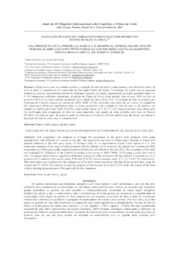Aceitação do leite de cabras suplementadas com diferentes fontes de óleo na dieta.
Aceitação do leite de cabras suplementadas com diferentes fontes de óleo na dieta.
Author(s): PEREIRA, L. P. da S.; BOMFIM, M. A. D.; MORAES, G. M. D. de; FARIAS, M. D. P.; LAGUNA, L. E.; LOBO, R. N. B.; GOMES, G. M. F.
Summary: Resumo: Objetivou-se com este trabalho avaliar a aceitação do leite de cabras suplementadas com diferentes fontes de óleo na dieta. O experimento foi conduzido na Faculdade Centro de Ensino Tecnológico do Ceará com as amostras obtidas no setor de caprinocultura leiteira da Embrapa Caprinos, em ensaio experimental em duplo quadrado latino 4 x 4. Os tratamentos avaliados consistiram na adição de fontes de óleo à dieta animal: óleo de soja (OS) ou óleo de palmiste (OPA) e um leite controle, produzido sem a adição de óleo à dieta (FO). A aceitação do leite foi avaliada por Diferença do Controle segundo as normas da ABNT-NBR 13.526, utilizando uma escala de um a cinco. Os julgadores não observaram diferença significativa entre os leites produzidos com a adição de óleo de soja ou de palmiste em relação ao controle pelo teste SNK (P>0,05), cujas médias foram; 4,17, 4,17 e 3,53, respectivamente. Esta observação foi confirmada pela comparação do leite de cada tratamento com aquele da dieta controle, pelo teste de Dunnet (P<0,05). Os óleos de soja e de palmiste pode ser utilizado em níveis de 2,5% da matéria seca das dietas, sem alterar a aceitação do leite de cabra para os consumidores. [Aceitability of milk from goats supplemented with different oil sources in the diet]. Abstract: This experiment was assigned to evaluate the acceptance of the goat?s milk produced from goats supplemented with different oil sources in the diet. The experiment was done at Technologic Institute of Ceará with samples obtained in the milk goat sector of Embrapa Goat, in an experimental double Latin Square 4 x 4. The treatments consisted of two types of milk produced with the addition of oil sources to the animal diet: soybean oil (SO) or palmiste oil (OPA) and a milk controls produced without the oil addition to the diet (FO). The acceptance of the milk was evaluated by Difference of the Control according to the norms of ABNT-NBR 13526 using a scale from one to five. The judges didn't observe significant difference among the milks produced with the addition of soybean oil or of palmiste oil in relation to the control using SNK test (P>0.05), whose averages were; 4.17, 4.17 and 3.53, respectively. This observation was confirmed by the comparison of the milk of each treatment with that of the controls diet, using the Dunnet test (P <0.05). The soybean oil and the palmiste oil can be used in levels of 2.5% of the dry matter of the diets without altering the acceptance of the goat milk for the consumers.
Publication year: 2007
Types of publication: Paper in annals and proceedings
Unit: Embrapa Goats & Sheep
Observation
Some of Embrapa's publications are published as ePub files. To read them, use or download one of the following free software options to your computer or mobile device. Android: Google Play Books; IOS: iBooks; Windows and Linux: Calibre.
Access other publications
Access the Agricultural Research Database (BDPA) to consult Embrapa's full library collection and records.
Visit Embrapa Bookstore to purchase books and other publications sold by Embrapa.

